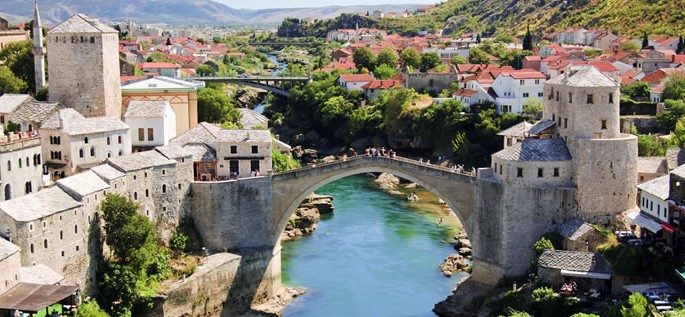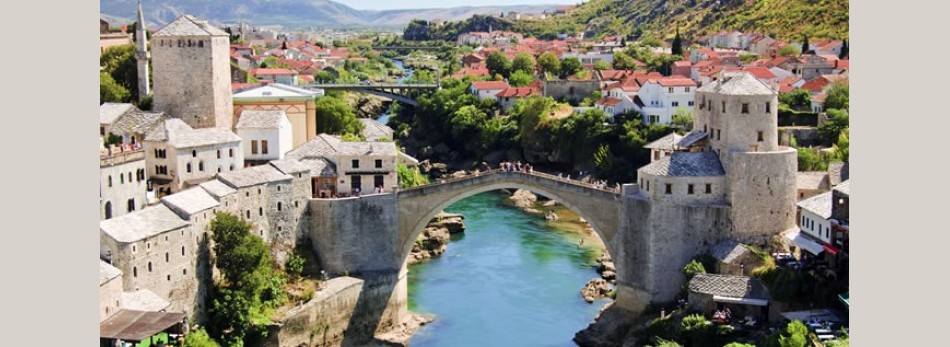Bosnian

Bosnian, босански (bosanski) belongs to the South Slavic group of the Slavic branch of the Indo-European language family. After the breakup of Yugoslavia, Serbo-Croatian, defined as the common language of Serbs, Croats, Bosniaks and Montenegrins, officially split into three mutually intelligible languages — Bosnian, Croatian and Serbian. These languages are based largely on political, rather than linguistic considerations. Although Serbian, Croatian and Bosnian differ in a number of ways, these differences do not affect their mutual intelligibility due to the fact that they share a common sound system, grammar, and vocabulary.
Status
Standard Bosnian, based on the Shtokavian dialect Ijekavian pronunciation, is the official language of Bosnia and Hercegovina. It is spoken by approximately 2 million people in Bosnia. It is also spoken in Serbia, Croatia, and Montenegro (Ethnologue). Standardization of Bosnian has not been completed due to disagreement among specialists about the features that make Bosnian uniquely distinct from Serbian and Croatian.
Dialects
The dialect picture for Bosnian, as well as for Serbian, and Croatian, is quite complex and is shared by all these languages. The major dialectal difference is based on the pronunciation of the initial consonant in the word for ‘what.’
|
Shtokavian
|
Chakavian
|
Kajkavian
|
|---|---|---|
|
shto
|
cha
|
kaj
|
Shtokavian, in turn, has three varieties, based on three different present-day pronunciations of the vowels that replaced the Common Slavic long vowel [æ], known as jat’.
|
Common Slavic
*væra ‘faith’ |
||
|---|---|---|
|
Ekavian
|
Ikavian
|
Ijekavian
|
|
vera
|
vira
|
vjera
|
|
Most widely spoken dialect on which Standard Serbian is based.
|
Spoken only in Croatia, serves as basis for standard Croatian.
|
Spoken in Bosnia and Herzegovina, it provides the basis for Standard Bosnian.
|
*reconstructed form
Structure
Vowels
Bosnian has 5 vowel phonemes, i.e., sounds that differentiate word meaning.
|
Front
|
Central
|
Back
|
|
|---|---|---|---|
| Close |
i
|
u
|
|
| Mid |
e
|
o
|
|
| Open |
a
|
Consonants
Bosnian has 25 consonant phonemes, i.e., sounds that differentiate word meaning. The consonants of Bosnian are given in the table below.
|
Bilabial
|
Labio-
dental |
Alveolar
|
Post-
alveolar |
Alveo-
palatal |
Palatal
|
Velar
|
||
|---|---|---|---|---|---|---|---|---|
| Stops |
voiceless
|
p
|
t
|
k
|
||||
|
voiced
|
b
|
d
|
g
|
|||||
| Fricatives |
voiceless
|
f
|
s
|
ʃ
|
x
|
|||
|
voiced
|
z
|
ʒ
|
||||||
| Affricates |
voiceless
|
ts
|
tʃ
|
tɕ
|
||||
|
voiced
|
dz
|
dʒ
|
dʑ
|
|||||
| Nasals |
m
|
n.
|
ɲ
|
|||||
| Laterals |
l
|
ʎ
|
||||||
| Rhotic |
r
|
|||||||
| Approximants |
ʋ
|
j
|
- /x/ = ch in Loch
- /ʃ/ =sh in shape
- /ʒ/ = s in measure;
- /tʃ/ = ch in chat
- /dʒ/ = j in jet
- /tɕ/ = t in nature
- /dʑ/ = j in juice
- /ɲ/ = ny in canyon
- /ʎ/ = ll in million
- /ɾ/ has no equivalent in English; it is similar to r in Spanish pero ‘but’
- /ʋ/ has no equivalent in English
- /j/ = y in yet
Like all Slavic languages, Bosnian allows a variety of consonant clusters. These are all voiced or all voiceless. The last consonant in the cluster determines whether the entire cluster is voiced or voiceless. This rule does not apply to nasals, laterals, or rhotics. The consonant /r/ can be syllable-forming, e.g., drvo ‘tree.’
Stress
Bosnian has a pitch stress. Monosyllabic words always have a falling tone. Words with two or more syllables may also have a falling tone, but (with the exception of foreign borrowings and interjections) it falls on the first syllable. However, these words may also have a rising tone on any syllable but the last.
Nouns
Bosnian nouns are marked for gender, number, and case. Case indicates the function of a noun and its relationship to other words in the sentence.It can also indicate pragmatic relationships. The three are fused into one ending, as is the case in all Slavic languages.
- genders: masculine, feminine, neuter;
- numbers: singular, plural, with some vestiges of dual;
- cases: nominative, genitive, dative, accusative, instrumental, locative, vocative; only a few nouns have retained the vocative forms, and the locative and dative forms are almost identical;
- Adjectives agree with the nouns they modify in gender, number, and case.
- There are no articles.
- Like all Slavic language, Bosnian makes a distinction between the informal ti and formal vi second-person pronouns. This distinction is reflected in the associated verb forms.
Verbs
Bosnian verbs agree with their subjects in person and number in the non-past, and in gender and number in the past. They are marked for the following categories:
- Three persons: first, second, third. Like all Slavic languages, Bosnian is a pro-drop language, i.e., personal pronouns are normally dropped because the verb ending makes the person clear. Pronouns are used only for emphatic purposes.
- Two tenses: past, non-past. Present and simple future tenses have the same endings.
- Two aspects: imperfective and perfective. Perfective and imperfective verbs are formed from basic verb roots by adding prefixes and suffixes. Non-past conjugation of perfective verbs indicates future tense, non-past conjugation of imperfective verbs indicates present tense. Imperfective verbs form the future tense with the auxiliary verb byt ‘be’.
- Three moods: indicative, imperative, conditional.
- Two voices: active, passive.
- Verbs of motion constitute a special subcategory of verbs. They are characterized by a complex system of directional and aspectual prefixes and suffixes.
Word order
The neutral word order in Bosnian is Subject-Verb-Object. However, other orders are possible since inflectional endings clearly mark grammatical relations and roles in the sentence. In general, word order is principally determined by topic (what the sentence is about, or old information) and focus (new information). Constituents with old information precede constituents with new information, or those that carry the most emphasis.
The basic vocabulary of Bosnian is Slavic in nature. The differences between Bosnian, on the one hand, and Serbian and Croatian, on the other, occur mostly in the lexicon. Croatian has preserved more native Slavic words, while Serbian has borrowed more from Russian and Western European languages. Bosnian is more like Croatian, except for the fact that it has a large number of loanwords from Arabic, Turkish, and Persian loanwords due to the Bosniaks’ religious affiliation with Islam.
An interesting difference in basic vocabulary between Serbian and Bosnian, on the one hand, and Croatian, on the other, involves the names of the months. While Serbian and Bosnian borrowed the names from Western European languages, Croatian uses inherently Slavic words, e.g., Croatian travanj and Serbian/Bosnian april, Croatian listopad (literally ‘leaf fall’) and Bosnian/Serbian oktobar.
Below are some common phrases in Bosnian.
|
Hello.
|
Zdravo. |
|
Good bye
|
Z bogom |
|
Please
|
Molim |
|
Thank you
|
Hvala. |
|
Excuse me
|
Izvini/izvinite
|
|
Yes
|
Da
|
|
No
|
Ne
|
| Man |
Čovek, muž
|
| Woman |
Žena
|
Below are the numerals 1-10 in Bosnian.
|
1
|
2
|
3
|
4
|
5
|
6
|
7
|
8
|
9
|
10
|
|---|---|---|---|---|---|---|---|---|---|
|
jedan
|
dva
|
tri
|
četiri
|
pet
|
šest
|
sedam
|
osam
|
devet
|
deset
|
|
један
|
два
|
три
|
четири
|
пет
|
шест
|
седам
|
осам
|
девет
|
десет
|
Writing
The original alphabet used by both the Serbs and Croats was Glagolitic. It was created by the monks Cyril and Methodius in the 9th century for Old Church Slavonic, the liturgical language of the Eastern Orthodox Church. In the Orthodox areas of Serbia and Bosnia, Glagolitic was replaced by the Cyrillic alphabet in the 12th century.
The Cyrillic alphabet (along with the Latin alphabet, which was adopted in the Catholic areas) was reformed in the 19th century to create a better one-to-one correspondence between sounds and letters as well as a one-to-one correspondence between the symbols in the Cyrillic and Latin alphabets. The Serbian Cyrillic alphabet was revised in the 19th century. The Croatian Latin alphabet was revised shortly afterwards by adding five extra symbols to the standard Latin alphabet by borrowing letters from Czech and Polish, and inventing the digraphs ‘lj’, ‘nj’ and ‘dž’ for phonemes represented by single letters in the Cyrillic alphabet. The two alphabets map well onto each other.
Today, Bosniaks and Croats in Bosnia and Herzegovina prefer the Latin alphabet, while Cyrillic is preferred by Bosnian Serbs. The two alphabets are given below.
|
Cyrillic
|
|||||||
|---|---|---|---|---|---|---|---|
| А а | Б б | Вв | Г г | Д д | Ђ ђ | Е е | Ж ж |
| З з | И и | J j | К к | Л л | Љ љ | М м | Н н |
| Њ њ | О о | П п | Р р | С с | Т т | Ћ ћ | У у |
| Ф ф | Х х | Ц ц | Ч ч | Џ џ | Ш ш | . | |
|
Latin
|
|||||||
|---|---|---|---|---|---|---|---|
| A a | B b | C c | Č č | Ć ć | D d | Dž dž | Đ đ |
| E e | F f | G g | H h | I i | J j | K k | L l |
| Lj lj | M m | N n | Nj nj | O o | P p | R r | S s |
| Š š | T t | U u | V v | Z z | Žž | . | . |
Take a look at Article 1 of the Universal Declaration of Human Rights in Bosnian Latin script.
|
Opća deklaracija o ljudskim pravima Članak 1 Sva ljudska bića rađaju se slobodna i jednaka u dostojanstvu i pravima. Ona su obdarena razumom i sviješću i trebaju jedno prema drugome postupati u duhu bratstva. |







